038 - Identifying & Preventing Porcupine Damage to Trees
The North American porcupine (Erethizon dorsatum) is one of the most widely distributed herbivores and the second largest member of the rodent family in North America. They are best known for their stout, quill-covered bodies, and their lumbering gait. Their habitats extend from alpine forest ecosystems in Alaska to cottonwood stands throughout the West to Mexico, and across the northern U.S. from California to Maine. Porcupines have strong, short legs for gathering food, and long claws on both their front and hind legs for efficient climbing. Their strong tails are able to grasp objects and also help to stabilize their bodies as they climb up and down trees. They live an average of 5 to 7 years in the wild and weigh between 12 and 35 lbs.
Food
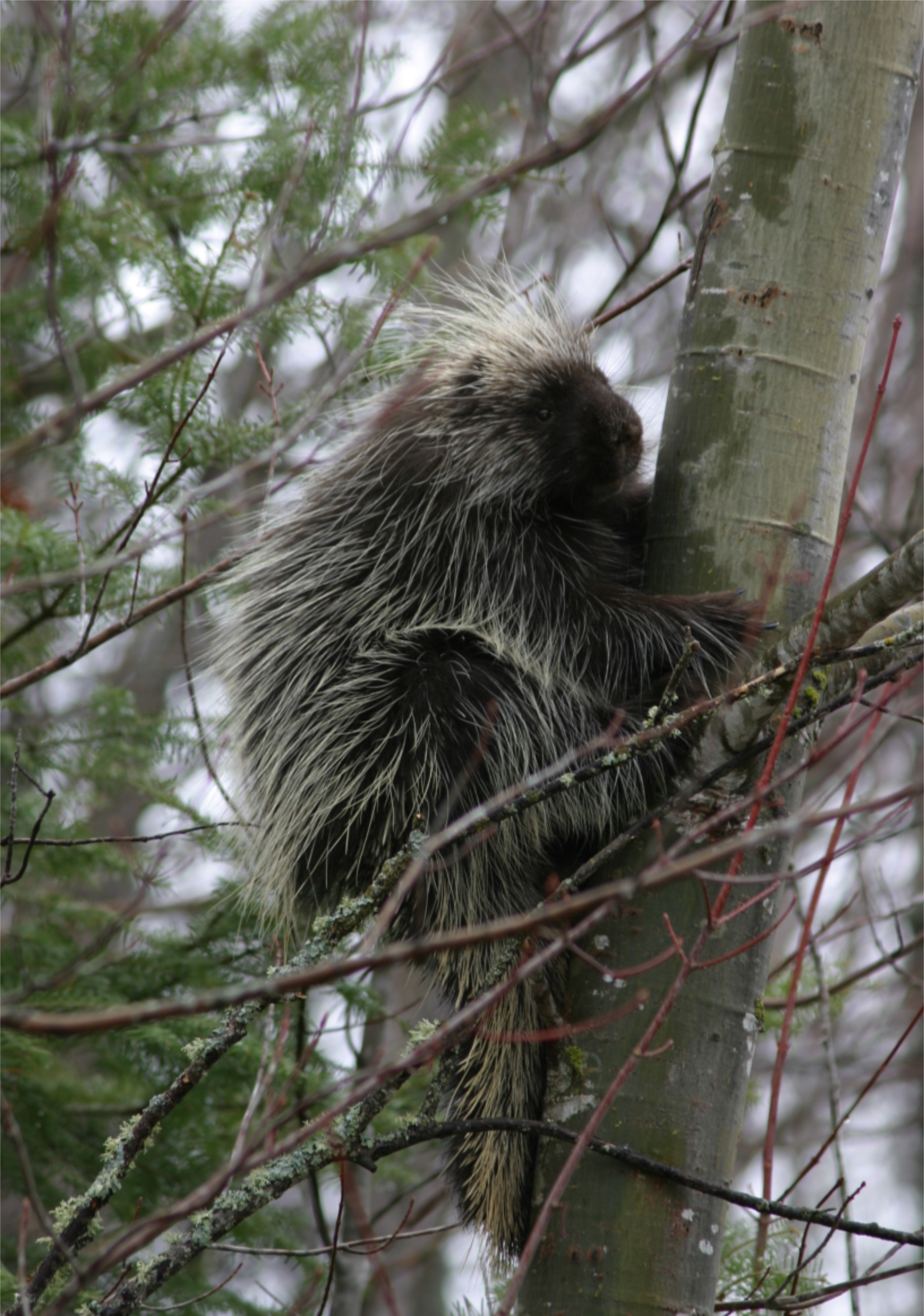
Photo courtesy Paul Bolstad, University of Minnesota
Depending on the season, porcupines eat a wide range of vegetation including bark, needles, leaves and the reproductive and readily eaten vegetative parts of woody plants, including nuts, seeds, fruits, and buds (these are considered mast). Due to their heavy bodies and short legs, porcupines cannot easily navigate deep snow, therefore wintertime adds extra pressure on this strict plant eater to find accessible and nutritionally dense food. Porcupines primarily feed in the tree canopy throughout the winter by chewing evergreen needles, bark, twigs, and buds off trees. In the interior West, including Utah, cottonwoods, willows, pines, Douglas-firs, spruces, and true firs are preferred by porcupines, especially for their bark. However, they will eat just about any kind of vegetation.
Behavior
Porcupines are primarily nocturnal, docile animals with few predators due to their quill-covered body. The name “porcupine” is very appropriate, coming as it does from the Latin porcus, meaning swine, and spina, meaning thorn. The literal translation of this is “the irritable back.” The porcupine uses its sharp quills to inflict harm to any would-be predators that get within close range. Contrary to some wildlife folklore, porcupines cannot “shoot” quills, rather their barbed quills penetrate and stick upon contact with any animal or object that it finds threatening. Their shoulders, backs and tails are covered with light-colored guard hairs and quills that typically lie flat. When threatened, porcupines will expel a pungent olfactory odor that alerts predators that they should retreat. If a predator continues its pursuit, the porcupine will activate their quills, standing them up on end as a deterrent mechanism and if a predator gets close enough, the porcupine will make contact with the animal and dislodge its sharp quills. Their tails have the highest density of quills on their bodies and they can quickly flick their tails to lodge quills into the skin of whatever is threatening them. One porcupine can have up to 30,000 quills on its body and can regrow any quills that are released. Interestingly, the quills of the North American porcupine are medicated with a topical antibiotic – a strategy that evolved to protect against “self-quilling”. Porcupines will also warn predators by making loud vocalizations.
Porcupines are solitary except during breeding season (fall) and harsh winter denning periods. They have their young from April to May and typically give birth to one ten-inch long “porcupette” that remains with its mother throughout the summer. Baby porcupines are born with soft quills and teeth which enable them to begin eating vegetation within the first week of life.
Conflicts with People

Tooth marks on a fresh wound caused by porcupine feeding. Photo courtesy USDA Forest Service
Unless provoked to defend themselves, porcupines will not normally quill intruders without advance warning. For this reason, conflicts with humans can be avoided and are unlikely. Porcupines pose more of a danger to other animals, primarily pets that may not heed porcupine forewarning. Once embedded, the grease-covered barbs on a quill are difficult and painful to remove. If you encounter a porcupine, you should back away slowly and leave it alone. One way to tell if a porcupine is in the area is to listen. They can make a wide range of vocalizations that resemble the sound of a kazoo.
Conflicts with Trees and Other Vegetation
Utah is centrally located in porcupine territory, but in Utah they are usually found in the woods away from people. However, as people relocate to areas known as the wildland-urban interface or WUI, they may encounter trees that have been damaged by porcupines. Porcupines prefer the young bark, leaves, and terminal twigs commonly found high up in the crown of a mature tree, but will strip bark anywhere on a tree’s trunk or branches. Like beavers, porcupines prefer to eat the nutritious inner tree bark or phloem. To get to it they have to remove the bark all the way down to the cambium layer of the tree, which is where the wood begins. If bark is stripped all the way in to the cambium then that part of the tree will die, though small wounds may eventually heal by new tissue growing from the edges of the wound. If porcupines remove the bark all the way around the trunk or a branch (girdling it), then the trunk or branch will be killed from that point up or out. This will weaken the tree and make it more vulnerable to damage from diseases, insects, and birds.
Grooved tooth marks approximately 5 mm wide are characteristic of porcupine damage. Squirrels and other small mammals will also remove tree bark, but small animals make smaller tooth marks. Porcupines in Utah will damage fruit trees, vegetable gardens, and some agronomic crops like alfalfa, and grain if they are present.
While porcupines may be a nuisance to homeowners with ornamental or fruit trees, their presence in the forest improves the function and diversity of these ecosystems. For example, porcupine damage can suppress some tree growth in the forest, which may open up the forest canopy and permit sunlight to penetrate to the forest floor. This can stimulate herbaceous understory vegetation which benefits different species than those that prefer a closed-canopy forest. In addition, trees that are killed and felled due to porcupine damage can provide shelter and nest sites for other wildlife. Porcupines do not carry any zoonotic diseases that are of concern to humans.
Protection
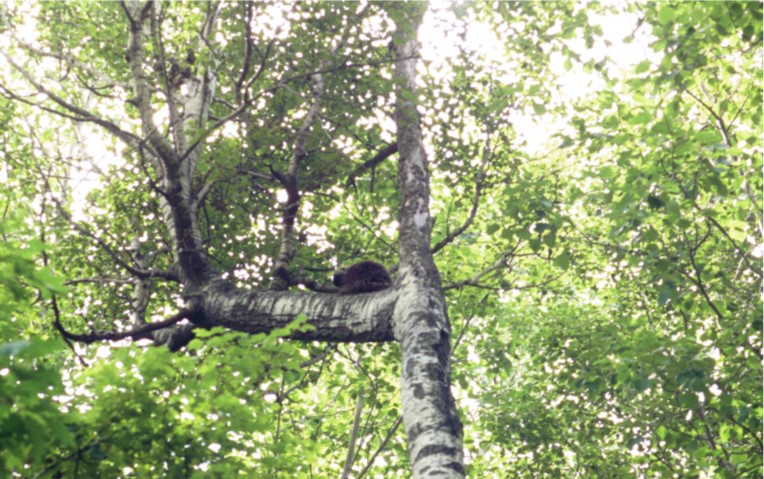
Photo courtesy Linda Haugen, USDA Forest Service
Exclusion by fencing is the most effective method for preventing porcupine damage to trees. Install 18 to 24 inch high woven wire fencing around gardens, orchards or specific areas of your property that require protection. We recommend folding down the top of the fence outward at a 65° angle to further discourage curious porcupines. Fences work best if an electric hot wire can be added 1.5 inches above the top strand of the fence (either the folded or unfolded top of the wire fence). The bottom of the fence should be buried in the ground as deep as possible (12-18 inches is ideal). To protect specific (large) trees, place a 30 inch wide band of aluminum flashing around the trunk to prohibit porcupines from accessing the trunk at ground level. Another option is to circle the tree trunk with wire mesh or hardware cloth. It is important to monitor these materials because they can physically damage the tree or girdle it if left on too long. Removing any attractants in your yard will help prevent nuisance porcupine occurrence
Porcupines like salt and salt is used in the tanning process of most leathers, therefore properly storing leather items such as gloves or horse harnesses or any other mineral rich leather items that may be laying around your yard can help discourage their visits. Porcupines are also attracted to the resins in plywood (often used in outdoor decks, outbuildings, etc.) and may chew on it as well. If this becomes a problem you may want to provide an alternate salt source such as a salt block to keep them from damaging structures.
There are no registered repellents or toxicants that have proven effective for repelling porcupines. One product however, Thiram is registered as a repellent for rodents and rabbits, and has incidentally repelled porcupines, as well. Despite this, no published research to date has demonstrated a product to be effective against repelling porcupines.
Nuisance Animal Removal and Relocation
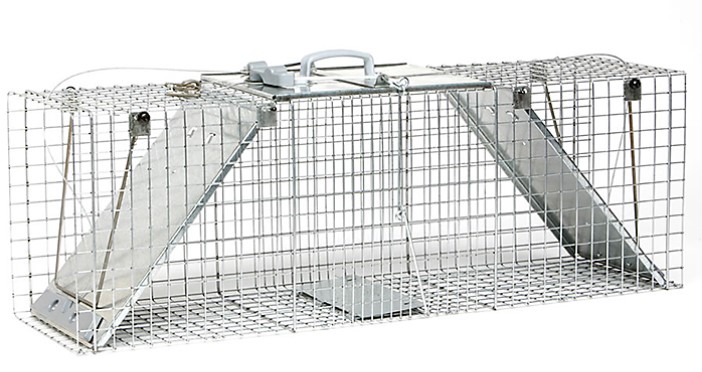
2-door spring-loaded trap. Photo courtesy havahart.com
Porcupine are constantly moving through forested areas in search of food and shelter, making complete removal, relocation, or eradication of these animals nearly impossible. Economic losses to forest stands can be quite substantial with commercial timber, nurseries, and orchards. Protection of trees through regular fencing, low strung electrical fencing, and trapping are the most efficient methods for reducing damage.
Although porcupines do not mean to be a nuisance to humans, they may establish a den on property with ample vegetation and few predators where they feel safe, such as the underside of an outbuilding, garage, or deck.
The Utah Division of Wildlife Resources states in code R657-3 that “A person shall obtain a certificate of registration before collecting, importing, transporting, or possessing any species of animal or its parts classified as prohibited or controlled”. Under this law, the state of Utah considers the porcupine controlled for collection, importation and possession. You can check the Utah code on collecting nongame animals. If you are facing a nuisance porcupine on your property, we recommend contacting a professional wildlife control officer for assistance in mitigating conflicts. Note: The Utah Division of Wildlife Resources provides the information on contacting a professional wildlife control officer as a public service. They are not affiliated with these companies and make no endorsements.
The following information is included for homeowners interested in trapping nuisance porcupines themselves. Obviously, all necessary permits must be obtained before attempting any of the following.
If a porcupine den has been located, a trap can be placed very close to the opening and baited with nutritionally dense and salty foods such as cut fruit, peanut butter, sunflower seeds, or nuts. Live traps can be purchased at local hardware or farm stores. Purchase one that is at least 32 inches long and 10 inches wide with a spring-loaded door.
If a porcupine has young, transport the entire family if possible. Porcupines have their young from April to May and the juveniles stay with the females for the first summer of their lives. Gloves should be worn when handling the trap to keep human scent to a minimum and to protect your skin when transporting the caught porcupines. Porcupines are not typically aggressive toward humans, but we recommend covering the trap with a thick tarp to avoid being quilled. Most animal control officers suggest moving porcupines 10-20 miles away in a wooded area that is not inhabited by humans.
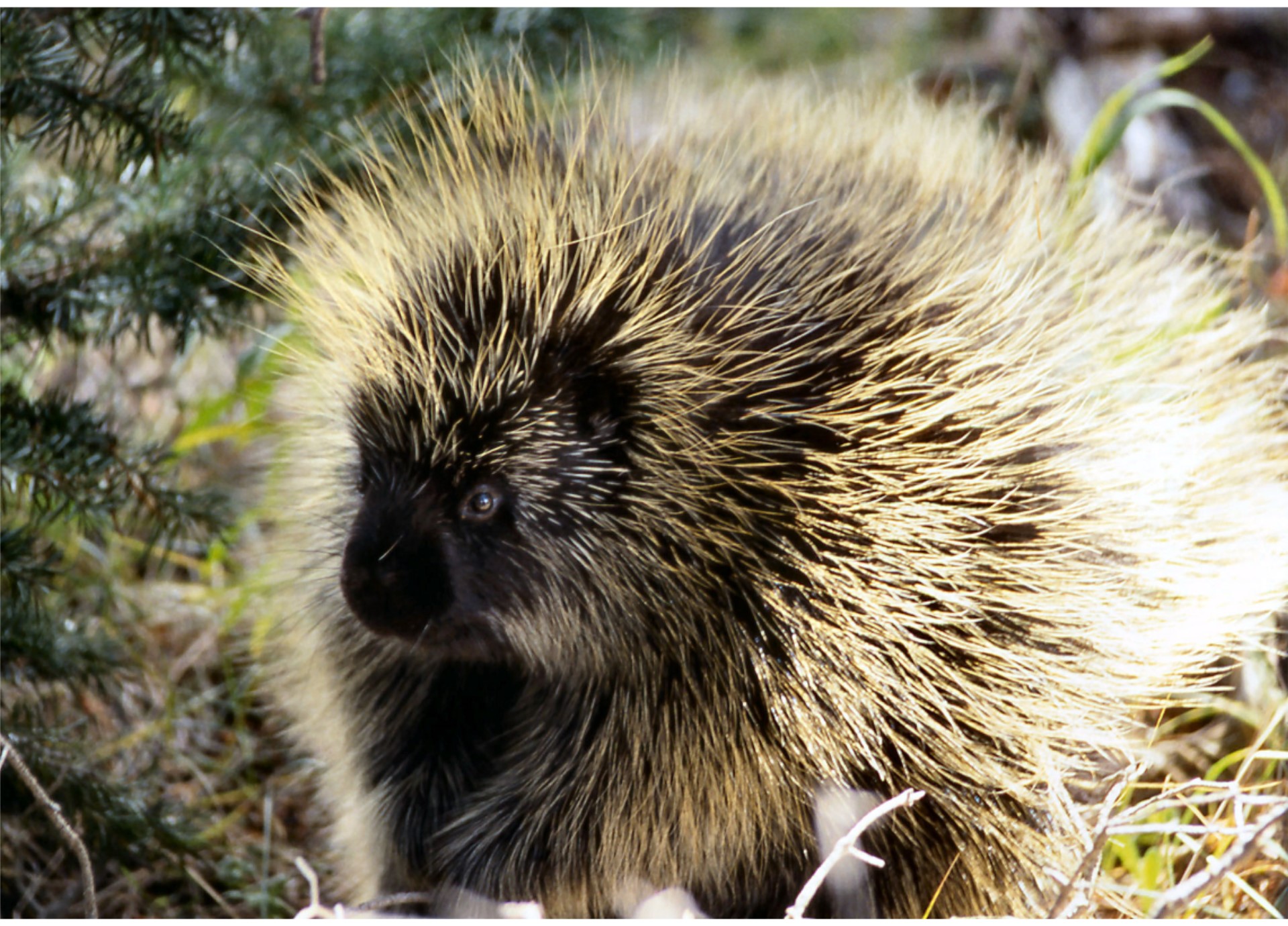 Photo courtesy National Park Service
Photo courtesy National Park Service
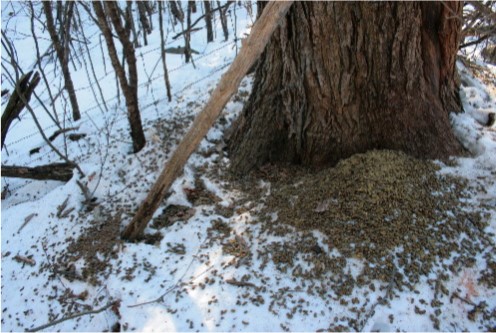 Porcupine den at the base of tree - easily recognizable by the latrine outside the opening. Photo courtesy Seabrook Leckie
Porcupine den at the base of tree - easily recognizable by the latrine outside the opening. Photo courtesy Seabrook Leckie
Resources
- Forest & Grassland Health, Porcupine Damage, USDA Forest Service. Accessed 4/11/19.
- Internet Center for Wildlife Damage Management. Accessed 2/26/19.
- Olson, R. & A. M. Lewis. 1999. Porcupine Ecology and Damage Management Techniques for Rural Homeowners. University of Wyoming Cooperative Extension. B-1073. 19 pg.
- Wild Aware Utah. Accessed 2/27/19.
- Many images came from Forestry Images
Published October 2019.

